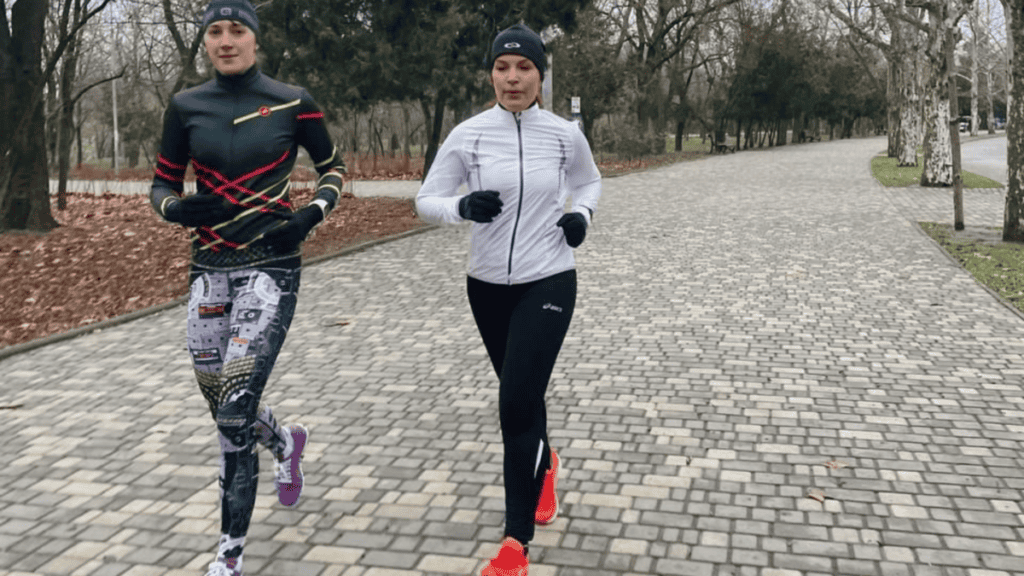
When it comes to training for trail running, I will be the first to admit that I’m extremely fortunate to live in the mountains of southern Spain. Just a few hundred yards from my front door is the edge of the Sierra Nevada National Park which extends over 330 square miles. This gives me ample opportunity to use trails for my training. However, during winter huge sections of the park are closed to public access so finding ways to train without trails is key.
We can mimic the varied terrain that trails offer by splitting our runs between gravel, sand, and grass. We can add targeted strength training in the gym to our training away from the trails to reduce the possibility of injuries to our stabilizing muscles when we return to the trails.
Let’s take a closer look at all the ways that we can train for trail running without using trails so that we don’t lose our fitness during those times when trails are not accessible.
How to Train for Trail Running without Trails
To train effectively for trail running without access to actual trails, it’s crucial to adopt a versatile approach that mimics the challenges of trail conditions. By incorporating varied terrain such as sand, gravel, and grass into your training regimen, you can enhance your adaptability and prepare your body for the unpredictability of trails. Running on sand can improve your balance and strengthen stabilizing muscles while navigating gravel helps build ankle stability and proprioception. Grass surfaces offer a softer landing, reducing the impact on joints and simulating the uneven terrain of trails.
This shift in mindset from traditional running methods to terrain-specific training is essential for trail runners looking to excel in non-trail environments. By embracing diverse surfaces and adjusting your training focus, you can effectively simulate the demands of trail running and enhance your overall performance. Incorporating these elements into your training routine will not only improve your physical conditioning but also sharpen your mental resilience and adaptability, key components for success in trail running competitions.
Utilizing Varied Terrain
To effectively prepare for trail running without access to trails, incorporating diverse surfaces like sand, gravel, and grass into your training regimen is crucial. These varied terrains play a vital role in mimicking the challenges of trail conditions. Running on sand enhances balance, strengthens stabilizing muscles, and improves proprioception. Gravel surfaces help build ankle stability and resilience, preparing you for the uneven terrain of trails. Grass surfaces offer a softer landing, reducing impact on joints and simulating the natural variability of trail surfaces.
By embracing these different terrains, you can enhance your adaptability, agility, and overall performance as a trail runner. Each surface presents unique challenges that help develop specific muscle groups and skills necessary for navigating trails effectively. Incorporating sand, gravel, and grass into your training routine not only diversifies your workouts but also better prepares your body for the unpredictability and demands of trail running. This terrain-specific training approach is essential for building a strong foundation and excelling in non-trail environments.
Strength and Stability Training
To enhance your performance in trail running without access to trails, incorporating strength and stability training is essential. Targeting key muscle groups like the glutes, core, and ankles can significantly improve your ability to navigate uneven terrain effectively.

For the glutes, exercises like squats, lunges, and hip bridges can help build strength and power, crucial for uphill climbs and maintaining stability on descents. Engaging the core through planks, Russian twists, and mountain climbers can improve balance and posture, reducing the risk of injury on challenging terrain. Strengthening the ankles with exercises like calf raises, ankle circles, and balance drills can enhance stability and proprioception, crucial for navigating rocky or technical trails.
By incorporating these specific exercises into your training routine, you can develop the strength, stability, and resilience needed to excel in trail running. Building a strong foundation in these key muscle groups will not only improve your performance but also reduce the risk of injuries in non-trail environments.
Simulating Elevation Changes
To simulate elevation changes when training for trail running without access to actual trails, there are several effective strategies you can implement. One approach is to utilize stairs, which can mimic the uphill and downhill challenges you would encounter on trails. Running up and down stairs can help build strength in your legs and improve your cardiovascular endurance.
Another option is to find hills or inclines in your area that you can incorporate into your training route. Running uphill can target similar muscle groups as trail running, such as the quads, hamstrings, and calves, while downhill running can help improve your agility and coordination.
If outdoor terrain is limited, using a treadmill with incline settings can also be a valuable tool. By adjusting the incline on the treadmill, you can replicate the varying degrees of elevation changes found on trails. This allows you to control the intensity of your workout and focus on specific aspects of uphill and downhill running.
By incorporating these strategies into your training regimen, you can effectively simulate elevation changes and better prepare yourself for the challenges of trail running, even in non-trail environments.
Navigating Technical Terrain
To navigate technical terrain effectively, it’s crucial to focus on honing your agility and balance. One effective way to achieve this is by incorporating agility ladder exercises into your training routine. Agility ladder drills can help improve your footwork, coordination, and quickness, which are essential skills for navigating challenging terrain.
Additionally, practicing hopping over obstacles in a controlled environment can further enhance your agility and balance. By simulating the need to quickly react and adjust your body position, you can better prepare yourself for the unpredictable nature of technical trails.
It’s also beneficial to work on strengthening your core muscles, as a strong core provides stability and helps you maintain balance on uneven surfaces. Incorporating exercises like planks, Russian twists, and stability ball exercises can help improve your overall stability and reduce the risk of injury while tackling technical terrain.
By consistently incorporating agility drills, balance exercises, and core strengthening into your training regimen, you can enhance your ability to navigate technical terrain with confidence and agility, even when training in non-trail environments.
Endurance Building Beyond Trails
To extend endurance beyond trails, incorporating interval training and long-distance road runs into your regimen can be highly effective. Interval training involves alternating between high-intensity bursts of exercise and periods of rest or lower intensity. This method not only improves cardiovascular fitness but also helps build endurance by pushing your body to adapt to different levels of intensity.

Long-distance road runs provide an opportunity to challenge your endurance in a different setting. While not on trails, these runs can still offer valuable endurance-building benefits. By gradually increasing your mileage and incorporating tempo runs or hill repeats, you can simulate the demands of trail running and enhance your overall endurance capacity.
Additionally, incorporating cross-training activities like cycling or swimming can help prevent overuse injuries while still improving cardiovascular fitness and endurance. These low-impact exercises provide a break from running while maintaining your endurance levels.
By diversifying your training routine with interval sessions, long-distance road runs, and cross-training activities, you can effectively build endurance even without access to long, uninterrupted trail routes.
Mental Preparation and Visualization
Mental resilience plays a crucial role in trail running, where unpredictable terrains and challenging conditions can test a runner’s endurance and determination. Visualization is a powerful technique that can help athletes prepare mentally for the demands of trail running. By visualizing themselves conquering steep ascents, navigating rocky paths, and pushing through fatigue, runners can build confidence and mental fortitude.
Positive self-talk is another effective strategy for overcoming challenges during trail running. Encouraging oneself with phrases like “I am strong,” “I can do this,” and “I am prepared for any obstacle” can boost morale and motivation when faced with tough moments on the trail. This optimistic mindset can help runners push through physical discomfort and mental fatigue, ultimately enhancing their performance.
Incorporating mental preparation techniques like visualization and positive self-talk into training routines can not only improve performance but also enhance overall mental resilience. By training the mind to stay focused, positive, and determined, trail runners can tackle obstacles with confidence and perseverance, leading to a more fulfilling and successful trail running experience.
Gear Selection and Adaptation
Transitioning from mental preparation to practical considerations, selecting the right footwear and gear is essential for trail running enthusiasts training without access to trails. When choosing footwear, it’s crucial to prioritize comfort, support, and traction to mimic the demands of trail surfaces. Opt for trail running shoes with durable outsoles, protective toe caps, and adequate cushioning to handle varied terrains effectively. Additionally, consider adapting your gear for non-trail environments by incorporating elements like ankle weights or resistance bands to simulate the challenges of trail running.
Apart from footwear, selecting appropriate clothing is also vital. Opt for moisture-wicking and breathable fabrics to manage sweat and maintain comfort during intense workouts. Layering options can help regulate body temperature in changing conditions, mimicking the variability of trail environments. Furthermore, accessories like hydration packs or waist belts can be adapted for use in non-trail settings to ensure proper hydration and nutrition during training sessions.
By carefully selecting and adapting gear for non-trail environments, trail runners can maintain their training intensity and simulate trail conditions effectively, enhancing their overall preparedness for future trail running challenges.
Utilizing Technology and Apps
Transitioning from gear selection and adaptation, technology plays a crucial role in enhancing training for trail running without access to trails. Utilizing GPS apps for route planning allows runners to map out varied terrains and simulate elevation changes, ensuring a diverse training experience. These apps provide valuable insights into distance covered, pace, and elevation gain, helping runners tailor their workouts to match trail running conditions.

Moreover, virtual reality simulations offer an immersive training environment where runners can navigate technical terrains and practice mental preparation. By engaging in virtual trail runs, athletes can enhance their spatial awareness, footwork, and decision-making skills, preparing them for the challenges of actual trail races.
Incorporating technology and apps into training routines not only adds a fun and interactive element but also enhances the overall effectiveness of non-trail workouts. By embracing these digital tools, trail running enthusiasts can stay motivated, track their progress, and continuously challenge themselves in the absence of physical trails.
Cross-Training for Trail Running
Transitioning from technology and app integration, cross-training emerges as a pivotal component in optimizing trail running performance. Engaging in activities like cycling and swimming not only provides a break from the repetitive nature of running but also targets different muscle groups, promoting overall strength and endurance. Yoga, with its focus on flexibility and balance, complements trail running by improving core stability and reducing the risk of injuries.
Cycling, in particular, aids in building leg strength and cardiovascular fitness, essential for conquering challenging terrains. Swimming offers a low-impact workout that enhances lung capacity and promotes full-body conditioning, crucial for sustained trail running efforts. Additionally, the mental benefits of cross-training cannot be overlooked, as these activities provide a refreshing change of scenery and a break from the monotony of traditional training routines.
By incorporating cross-training activities into their regimen, trail runners can achieve a well-rounded fitness level, prevent overuse injuries, and enhance their performance on trails. Embracing a diverse training approach not only improves physical capabilities but also adds variety and enjoyment to the overall training experience.
Nutrition and Hydration Strategies
Transitioning from cross-training to nutrition and hydration strategies is crucial for optimizing performance in trail running without trails. Trail runners must prioritize fueling and hydrating effectively to sustain endurance efforts in varied terrains and conditions.
When it comes to nutrition, focusing on a balanced diet rich in carbohydrates, proteins, and healthy fats is essential for providing the energy needed for long runs. Tailoring intake to match the demands of trail running, such as incorporating easily digestible snacks and meals, can help maintain energy levels throughout the run. Hydration is equally vital, with trail runners needing to stay hydrated to prevent fatigue and maintain performance.
Incorporating electrolyte-rich drinks or supplements can help replenish lost minerals due to sweating during intense runs. Additionally, strategic hydration planning, such as carrying a hydration pack or planning water stops along the route, is key to ensuring adequate fluid intake during longer trail runs.
By understanding the unique nutritional and hydration needs of trail running, runners can fuel their bodies effectively, optimize performance, and enhance their overall trail running experience.
Rest and Recovery in Non-Trail Environments
Rest and recovery play a crucial role in any training regimen, including trail running in non-trail environments. While the natural surroundings of trails offer a serene and rejuvenating atmosphere for recovery, it’s essential to understand how to optimize rest and recovery even without the restorative ambiance of nature.
In non-trail environments, creating a conducive space for rest is key. This can involve setting up a designated area for relaxation, free from distractions and noise. Incorporating relaxation techniques such as deep breathing, meditation, or gentle stretching can help the body unwind and recover effectively.
Moreover, prioritizing quality sleep is paramount for recovery. Establishing a consistent sleep schedule and ensuring a comfortable sleep environment can aid in maximizing the body’s repair and regeneration processes.
Additionally, active recovery strategies like foam rolling, gentle yoga, or low-impact activities can promote blood flow, reduce muscle soreness, and enhance overall recovery. By implementing these rest and recovery practices in non-trail environments, trail runners can optimize their training, prevent injuries, and maintain peak performance levels.
